Today starts the 32nd edition of Il Cinema Ritrovato, and we're in Bologna, Italy to enjoy the festival. One of the classics programmes is One Hundred years Ago: 1918. One the main European stars of that year was German actress, writer and producer Hedda Vernon (1886-1925). During the 1910s, she appeared in more than 60 films and she was such a popular star that she got her own Hedda-Vernon-serial.

German postcard by Rotophot in the Film Sterne series, no. 232/1. Photo: Becker & Maass / Eiko-Film.
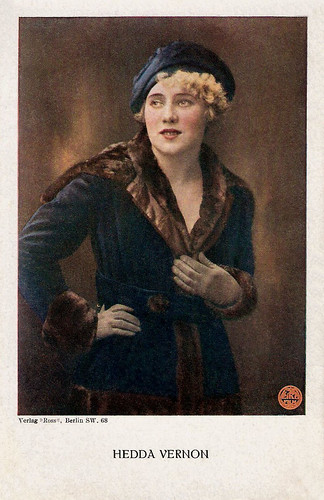
German postcard by Ross Verlag, Berlin, no. 2001/12, 1919-1924. Photo: Becker & Maass / Eiko Film.

German postcard by Ross Verlag, no. 360/2, 1919-1924. Photo: Becker & Maass Phot.
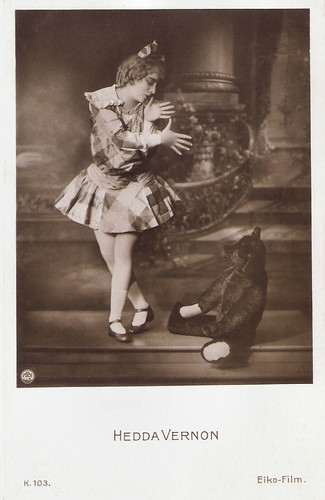
German postcard by Photochemie, Berlin, no. K. 103. Photo: Eiko-Film.
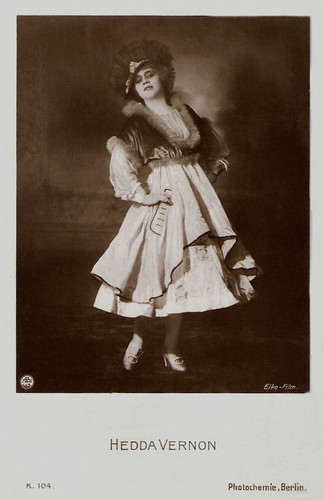
German postcard by Photochemie, Berlin, no. K. 104. Photo: Eiko-Film.
Hedda Vernon (sometimes credited as Hedda Vernon-Moest) was born in 1886.
In 1912 she made her first film appearances in silent shorts for the Deutsche Bioscop GmbH in Berlin. That year she appeared in Die Papierspur/The Paper Trail (Emil Albes, 1912), Die Rote Jule/Red Jule (Emil Albes, 1912) and Der Kampf um das Erbe/The Conflict about the Heritage (Max Obal, 1912).
The following years, she played in Vitascope productions directed by Harry Piel, like Menschen und Masken 1 & 2/People and Masks 1 and 2 (Harry Piel, 1913), Die Millionenmine/The Millions Mine (Harry Piel, 1914) and Die braune Bestie/The Brown Beast (Harry Piel, 1914).
But she worked most often with her husband, actor-director Hubert Moest. They made a series of Eiko-productions, including Zofenstreichen/Abigail Paintings (Hubert Moest, 1915), Maria Niemand und Ihre Zwölf Väter/Maria Nobody and Her Twelve Fathers (Hubert Moest, 1915) with Theodor Loos, and Das Bild der Ahnfrau/The Picture of the Ancestress (Hubert Moest, 1916) with Rudolf Forster and Harry Liedtke.
These were followed by Noemi die blonde Judin/Noemi the Blonde Jew (Hubert Moest, 1917), Der Peitschenhieb/The Whiplash (Hubert Moest, 1918), and Taumel/Rapture (Hubert Moest, 1919) with Alfred Abel and Paul Hartmann.
In Zofia (Hubert Moest, 1915), Hedda Vernon impersonated a fifteen year old girl although she was almost 29 at the time. Such ‘child parts’ were normal for actresses in the 1910s and 1920s.
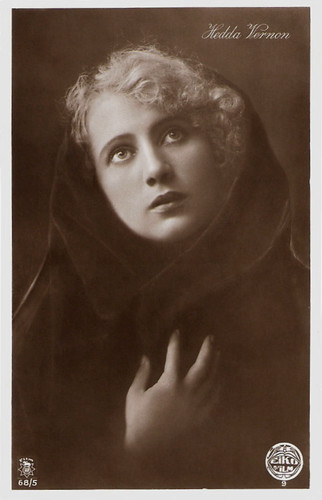
German postcard by Rotophot in the Film Sterne series, no. 68/5. Photo: Eiko-Film.
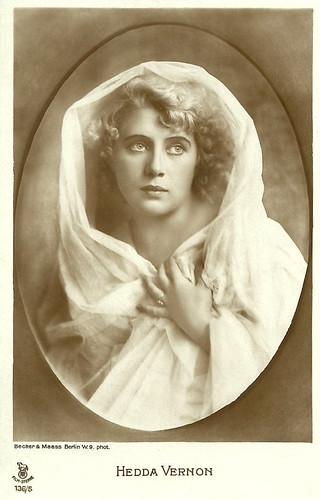
German postcard by Rotophot in the Film Sterne Series, no. 136/5. Photo: Becker & Maass, Berlin.
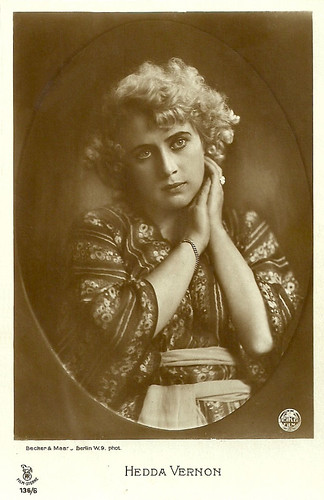
German postcard by Rotophot in the Film-Sterne Series, no. 138/6. Photo Becker & Maass, Berlin / Eiko Film.
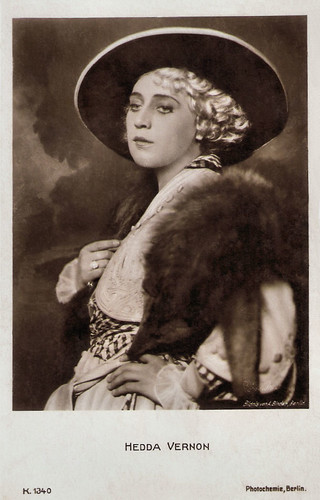
German postcard by Photochemie, Berlin, no. K. 1340. Photo: Alex Binder.

German postcard by Photochemie, no. K. 1346. Photo: Alex Binder.
Hedda Vernon became so popular that she got her own serial which was financed by her production company Vernon-Produktion. She produced herself in Selbstgerichtet oder Die gelbe Fratze/Self Defence or The Yellow Grimace (Hubert Moest, 1914) and Hedda Vernon’s Bühnensketch/Hedda Vernon's Stage Sketch (Hubert Moest, 1916).
She also worked with director Richard Oswald on Der Eiserne Kreuz/The Iron Cross (1914) with Hanni Weisse, Der Tod des andern/Other's Death (1919) with Alwin Neuss, and Manolescus Memoiren/The Memories of Manolescu (1920) starring Conrad Veidt.
During the 1920s, the interest in Hedda Vernon flagged. New stars became more in demand. To her few films in the 1920s belong Der Verächter des Todes/The Death Defier (Harry Piel, 1920), the Harry Piel series Der Reiter ohne Kopf/The Horseman Without a Head (Harry Piel, 1921) and Die Sonne von St. Moritz/The Sun of St. Moritz (Friedrich Weissenberg, Hubert Moest, 1923).
Her last film was Zwischen zwei Frauen/Between Two Women (Hubert Moest, 1925) opposite Reinhold Schünzel.
Hedda Vernon died that same year, at an unknown location, and of unknown causes. She was married with producer-director Hubert Moest from 1913 till 1920.
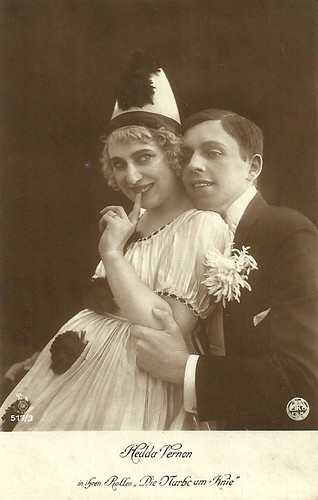
German postcard by Rotophot in the Film-Sterne series, no. 517/3. Photo: Eiko-Film. Hedda Vernon in Die Narbe am Knie (Hubert Moest, 1917).
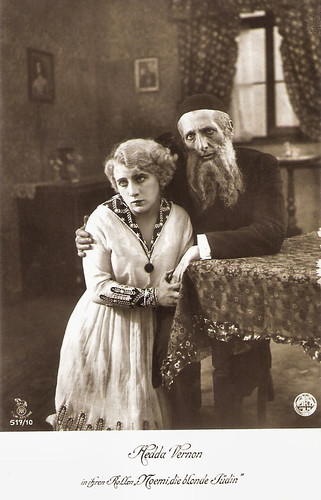
German postcard by Rotophot in the Film-Sterne series, no. 517/10. Photo: Eiko Film. Publicity still of Hedda Vernon in Noemi, die blonde Jüdin (Hubert Moest, 1917).

German postcard by Rotophot in the Film-Sterne series, no. 518/1. Photo: Eiko Film. Hedda Vernon in Mouschy (Hubert Moest, 1918).
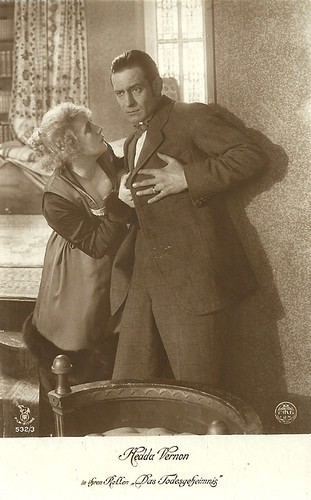
German postcard by Rotophot in the Film-Sterne series, no. 532/3. Photo: Eiko Film. Hedda Vernon and Erich Kaiser-Titz in Das Todesgeheimnis (Hubert Moest, 1918). Vernon co-scripted this film, with Ruth Goetz - who wrote several scripts for the Hedda Vernon films of the late 1910s.

German postcard by Rotophot in the Film-Sterne series, no. 532/6. Photo: Eiko Film. Hedda Vernon in Der Übel größtes aber ist die Schuld (Hubert Moest, 1918).
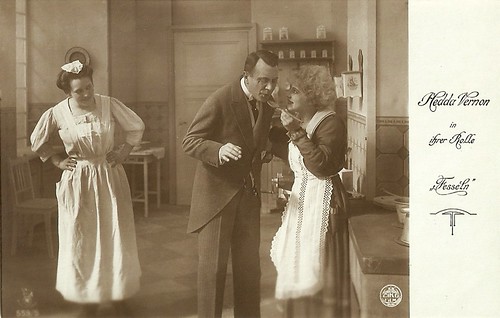
German postcard by Rotophot in the Film-Sterne series, no. 559/5. Photo: Eiko Film. Hedda Vernon in Fesseln/Chains (Hubert Moest, 1918).

German postcard by Rotophot in the Film Sterne Series, no. 560/2. Photo: Eiko Film. Publicity still for Wo ein Wille, ist ein Weg (Hubert Moest, 1918) with in the back right Ernst Hofmann.
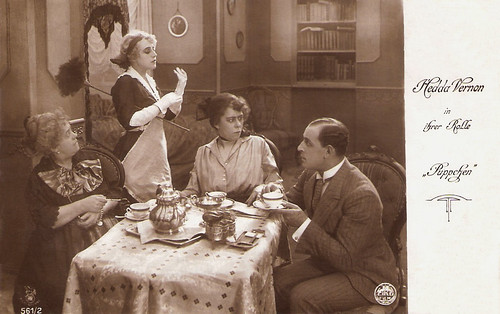
German postcard by Rotophot in the Film-Sterne series, no. 561/2. Photo: Eiko Film. Hedda Vernon in Puppchen/Dolly (Hubert Moest, 1918).
Sources: Thomas Staedeli (Cyranos), Filmportal.de, Wikipedia (German) and IMDb.

German postcard by Rotophot in the Film Sterne series, no. 232/1. Photo: Becker & Maass / Eiko-Film.

German postcard by Ross Verlag, Berlin, no. 2001/12, 1919-1924. Photo: Becker & Maass / Eiko Film.

German postcard by Ross Verlag, no. 360/2, 1919-1924. Photo: Becker & Maass Phot.

German postcard by Photochemie, Berlin, no. K. 103. Photo: Eiko-Film.

German postcard by Photochemie, Berlin, no. K. 104. Photo: Eiko-Film.
Child Parts
Hedda Vernon (sometimes credited as Hedda Vernon-Moest) was born in 1886.
In 1912 she made her first film appearances in silent shorts for the Deutsche Bioscop GmbH in Berlin. That year she appeared in Die Papierspur/The Paper Trail (Emil Albes, 1912), Die Rote Jule/Red Jule (Emil Albes, 1912) and Der Kampf um das Erbe/The Conflict about the Heritage (Max Obal, 1912).
The following years, she played in Vitascope productions directed by Harry Piel, like Menschen und Masken 1 & 2/People and Masks 1 and 2 (Harry Piel, 1913), Die Millionenmine/The Millions Mine (Harry Piel, 1914) and Die braune Bestie/The Brown Beast (Harry Piel, 1914).
But she worked most often with her husband, actor-director Hubert Moest. They made a series of Eiko-productions, including Zofenstreichen/Abigail Paintings (Hubert Moest, 1915), Maria Niemand und Ihre Zwölf Väter/Maria Nobody and Her Twelve Fathers (Hubert Moest, 1915) with Theodor Loos, and Das Bild der Ahnfrau/The Picture of the Ancestress (Hubert Moest, 1916) with Rudolf Forster and Harry Liedtke.
These were followed by Noemi die blonde Judin/Noemi the Blonde Jew (Hubert Moest, 1917), Der Peitschenhieb/The Whiplash (Hubert Moest, 1918), and Taumel/Rapture (Hubert Moest, 1919) with Alfred Abel and Paul Hartmann.
In Zofia (Hubert Moest, 1915), Hedda Vernon impersonated a fifteen year old girl although she was almost 29 at the time. Such ‘child parts’ were normal for actresses in the 1910s and 1920s.

German postcard by Rotophot in the Film Sterne series, no. 68/5. Photo: Eiko-Film.

German postcard by Rotophot in the Film Sterne Series, no. 136/5. Photo: Becker & Maass, Berlin.

German postcard by Rotophot in the Film-Sterne Series, no. 138/6. Photo Becker & Maass, Berlin / Eiko Film.

German postcard by Photochemie, Berlin, no. K. 1340. Photo: Alex Binder.

German postcard by Photochemie, no. K. 1346. Photo: Alex Binder.
Harry Piel Series
Hedda Vernon became so popular that she got her own serial which was financed by her production company Vernon-Produktion. She produced herself in Selbstgerichtet oder Die gelbe Fratze/Self Defence or The Yellow Grimace (Hubert Moest, 1914) and Hedda Vernon’s Bühnensketch/Hedda Vernon's Stage Sketch (Hubert Moest, 1916).
She also worked with director Richard Oswald on Der Eiserne Kreuz/The Iron Cross (1914) with Hanni Weisse, Der Tod des andern/Other's Death (1919) with Alwin Neuss, and Manolescus Memoiren/The Memories of Manolescu (1920) starring Conrad Veidt.
During the 1920s, the interest in Hedda Vernon flagged. New stars became more in demand. To her few films in the 1920s belong Der Verächter des Todes/The Death Defier (Harry Piel, 1920), the Harry Piel series Der Reiter ohne Kopf/The Horseman Without a Head (Harry Piel, 1921) and Die Sonne von St. Moritz/The Sun of St. Moritz (Friedrich Weissenberg, Hubert Moest, 1923).
Her last film was Zwischen zwei Frauen/Between Two Women (Hubert Moest, 1925) opposite Reinhold Schünzel.
Hedda Vernon died that same year, at an unknown location, and of unknown causes. She was married with producer-director Hubert Moest from 1913 till 1920.

German postcard by Rotophot in the Film-Sterne series, no. 517/3. Photo: Eiko-Film. Hedda Vernon in Die Narbe am Knie (Hubert Moest, 1917).

German postcard by Rotophot in the Film-Sterne series, no. 517/10. Photo: Eiko Film. Publicity still of Hedda Vernon in Noemi, die blonde Jüdin (Hubert Moest, 1917).

German postcard by Rotophot in the Film-Sterne series, no. 518/1. Photo: Eiko Film. Hedda Vernon in Mouschy (Hubert Moest, 1918).

German postcard by Rotophot in the Film-Sterne series, no. 532/3. Photo: Eiko Film. Hedda Vernon and Erich Kaiser-Titz in Das Todesgeheimnis (Hubert Moest, 1918). Vernon co-scripted this film, with Ruth Goetz - who wrote several scripts for the Hedda Vernon films of the late 1910s.

German postcard by Rotophot in the Film-Sterne series, no. 532/6. Photo: Eiko Film. Hedda Vernon in Der Übel größtes aber ist die Schuld (Hubert Moest, 1918).

German postcard by Rotophot in the Film-Sterne series, no. 559/5. Photo: Eiko Film. Hedda Vernon in Fesseln/Chains (Hubert Moest, 1918).

German postcard by Rotophot in the Film Sterne Series, no. 560/2. Photo: Eiko Film. Publicity still for Wo ein Wille, ist ein Weg (Hubert Moest, 1918) with in the back right Ernst Hofmann.

German postcard by Rotophot in the Film-Sterne series, no. 561/2. Photo: Eiko Film. Hedda Vernon in Puppchen/Dolly (Hubert Moest, 1918).
Sources: Thomas Staedeli (Cyranos), Filmportal.de, Wikipedia (German) and IMDb.
No comments:
Post a Comment